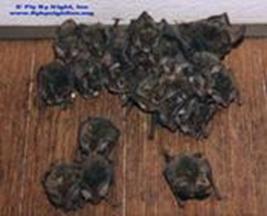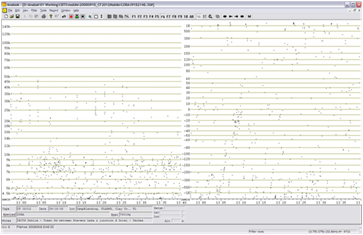
|
Fly By Night, Inc. is recognized by the IRS as a Section 501(c)(3) non-profit / tax-exempt organization. Donations are tax-deductible and all donated funds directly support our bat conservation efforts. CH12360
All content on this site is property of Fly By Night, Inc, and not to be duplicated for use without written permission |

|
Southeastern Big-eared Bat, Corynorhinus rafinesquii macrotis |



|
Corynorhinus rafinesquii (CORA) Anabat files recorded in Clay co, FL, Sept 2008
|
CORAEcholocation: Produce low intensity echolocation calls that are difficult to pick up on bat detectors, may have to be < 20 ft to be detected by Anabat.
Florida Distribution: Only five maternity colonies have been documented in Florida. The population status of two colonies remains unknown after loss of the original roost site. Individual BEB’s have been recorded as far south as the Big Cypress Swamp in Collier County, but southernmost maternity site is in Polk County.
Roosting Behavior: Colonial. Often roost solitary (males) or in small groups (3 – 7). In FL, maternity colonies average 30 – 40 bats. Documented roosts include abandoned structures and low level cavities in gum, cypress, and magnolia (Finn 2001). Sensitive to disturbance, will abandon roost sites. The status of maternity colony that roosted under a Union County bridge, replaced with box culverts in December 1999 (Finn, unpub) remains unknown. Uses bat houses? Yes, but only of special design Nuisance colonies? No Foraging Behavior: Habitat in and adjacent to mature swamps & forested wetlands associated with streams. Prefer moths & soft-bodied insects gleaned from foliage. Moth specialist. Reproduction: In Florida, single pup born early May.] Management and Conservation Recommendations: This species may be in the greatest need of conservation efforts. Conservation of forested wetlands, mature swamps and adjacent habitat, preservation of cavity trees (especially Nyssa) and protection of abandoned structures will benefit this and other bat species. Installation of large artificial roosts (i.e. modified concrete culverts) should be considered (see BCI 2002-2003 Annual Report, pg 4; Finn 2002). |
|
Free Info |
|
What We Do |
|
Who We Are |
|
How To Help |
|
Take A Peek |
|
Live Bats |
|
Urban Bat Status |
|
Buildings |
BatHouses |
|
Yes** |
Yes** |
|
Description—Measurements |
|||||
|
Mass g |
FA mm |
Wingspan |
Total length |
Tragus |
Calcar |
|
7 - 13 |
40 - 46 |
260 - 301 |
81 - 110 |
pointed |
|
|
large rabbit-like ears (26-31 mm) that are curled when at rest or torpid, 2 large lumps in front of eyes, white tipped fur below |
|||||
|
Status |
|||
FWS / USGS |
Florida |
FNAI |
IUCN |
|
Former C2 / SAR |
Rare / S2 |
G3/G4 |
VU |
|
Status & distribution under review by USFWS (Dec 2008). |
|||

